Aboriginal Desert Landscape Colour Palettes
When people think of desert landscapes they tend to think of earth colours and the ochre colours of traditional palettes. However when we look at modern, contemporary Aboriginal desert landscape painters and break down the colours and look closely at the colour palettes they're using, we see what an intense selection of colours the artists are taking from their palettes. The colour range has a surprising energy and brightness. Maybe it's not so surprising when we think that colour is such an important element of art and especially of desert art. It tends to put us in the mood of these big dominant landscapes with big skies with large amounts of the earth and rock faces exposed and all the plants. There is a sense that the artists draw on the rich resources seen in nature all around them. This comes through in the colour palettes the artists have contructed.
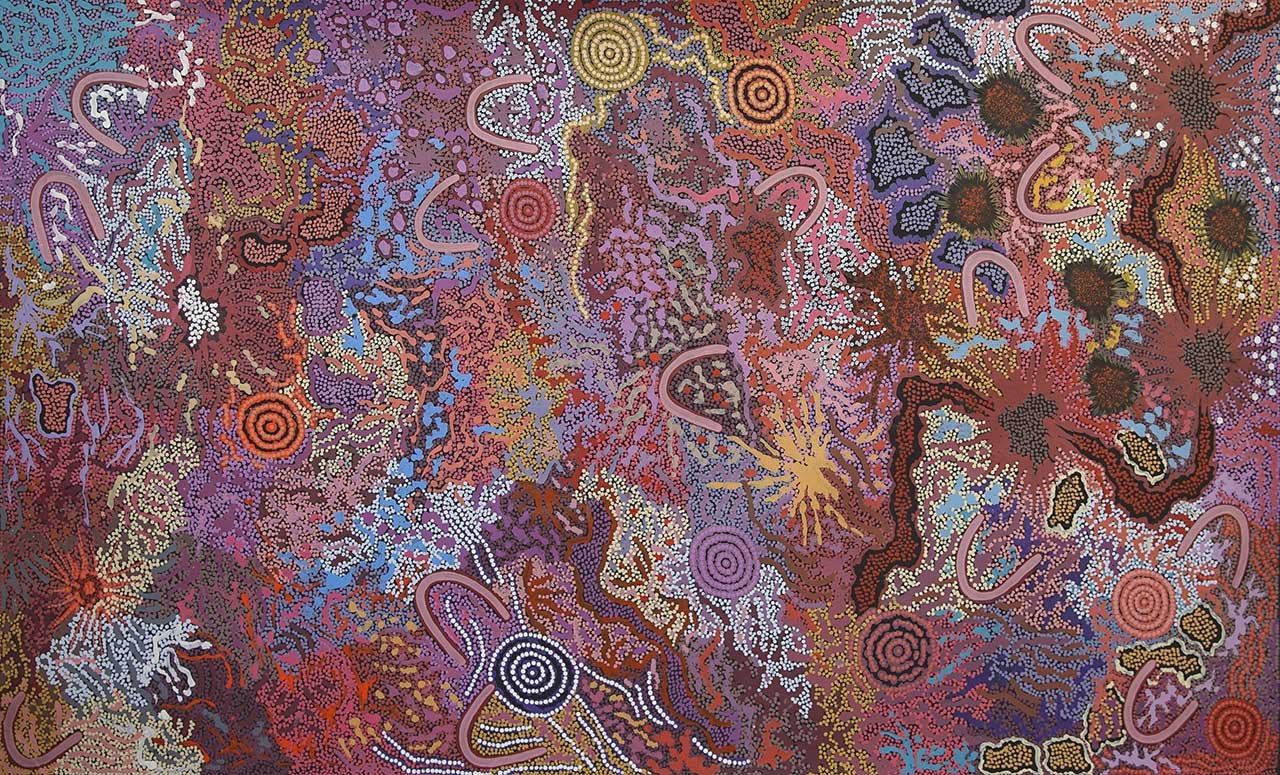
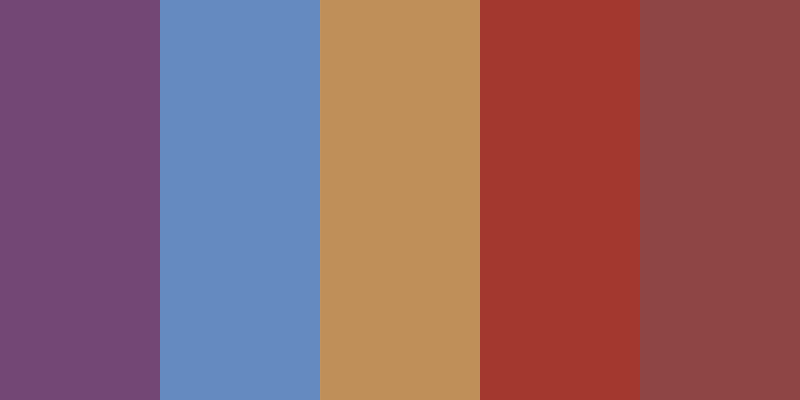
Gabriella Possum Nungurrayi | Grandmothers Country
Gabriella Possum Nungurrayi paints the significant sites and images from her grandmother’s country. These are Women’s Dreaming stories on her ancestral lands. The palette that she uses is distictive, it is at least partly derived from the colour palette used by her famous father, Clifford Possum. There is an unusual predominance of muted earthy pink colours and mauve colours going right through to darker pinks and reds. All of which sets up a reference to the Women’s Dreaming stories by the significance of those harmonious and very warm colour tones that she has selected. These contrast with some blues and small amounts of yellows and black and white. The stories that Gabriella paints are very complex, and the way that she combines these colour groups makes for a very complex and densely worked canvas.
(Jap 014313)
View Gabriella Possum Nungurrayi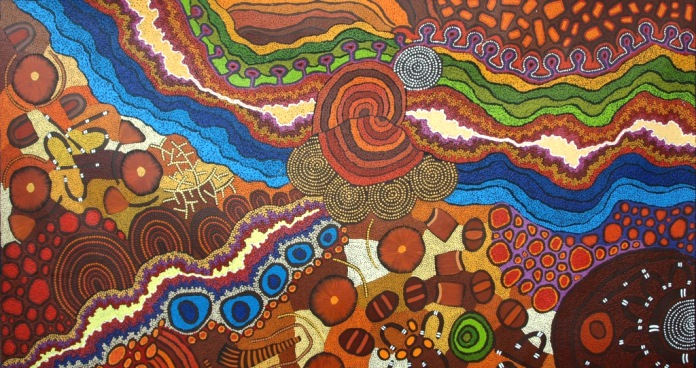

Damien and Yilpi Marks | My Country
Damien and Yilpi Marks are great storytellers from Central Australia. They use symbols of their Country partly shared from senior artists who have taught Damien Marks when he was a young man, including the famous artist Clifford Possum. This work is a collaboration between a husband and wife team. They use some of the most intense colours of any of the Central Desert artists that we exhibit at the gallery. They use a range of blues, aquas and greens representing the more fertile and watered part of the country. Then they employ the colours of the earth, so there are tones of browns and oranges and yellows. The iconography of the desert shows people camping at certain sites and various artefacts related to the ceremonial processes that are going on on traditional lands. There are intense colour contrasts between the cool blues and greens against the much hotter earthy colours with the addition of reds and mauves and purples.
(Jap 014106)
View Damien and Yilpi Marks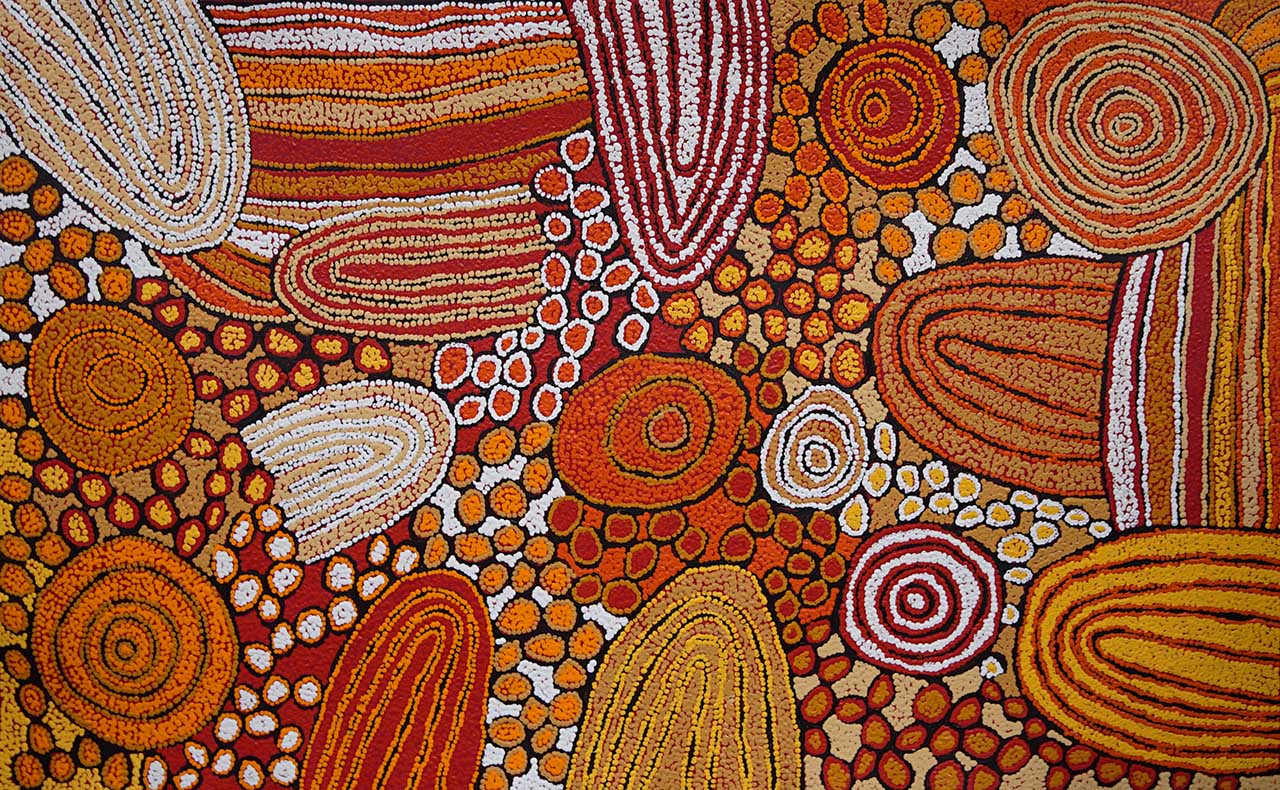
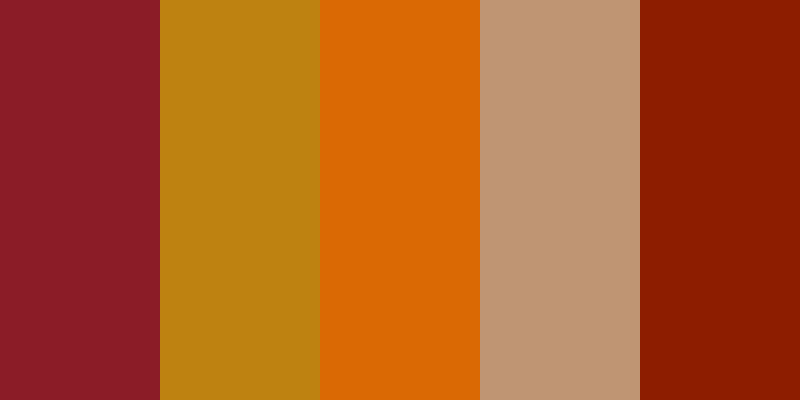
Katherine Marshall Nakamarra | Tjintjintjin
Katherine Marshall Nakamarra paints the ceremonial sites and stories that she has inherited through her mother, the famous artist Walangkura Napanangka. They represent a women’s ceremonial site on her own country near Kintore. The colours that she uses are very much the colours of the earth, ranging through reds, oranges, tans and browns. She represents the rocky country where this ceremonial site is located. The area is surrounded by hills. She marks out the ceremonial sites as concentric circles. This is a landscape painting utilising elements of the Western Desert symbolism and using what we would associate as the very earth colours of this open sandy and rocky country.
(Jap 013900)
View Katherine Marshall Nakamarra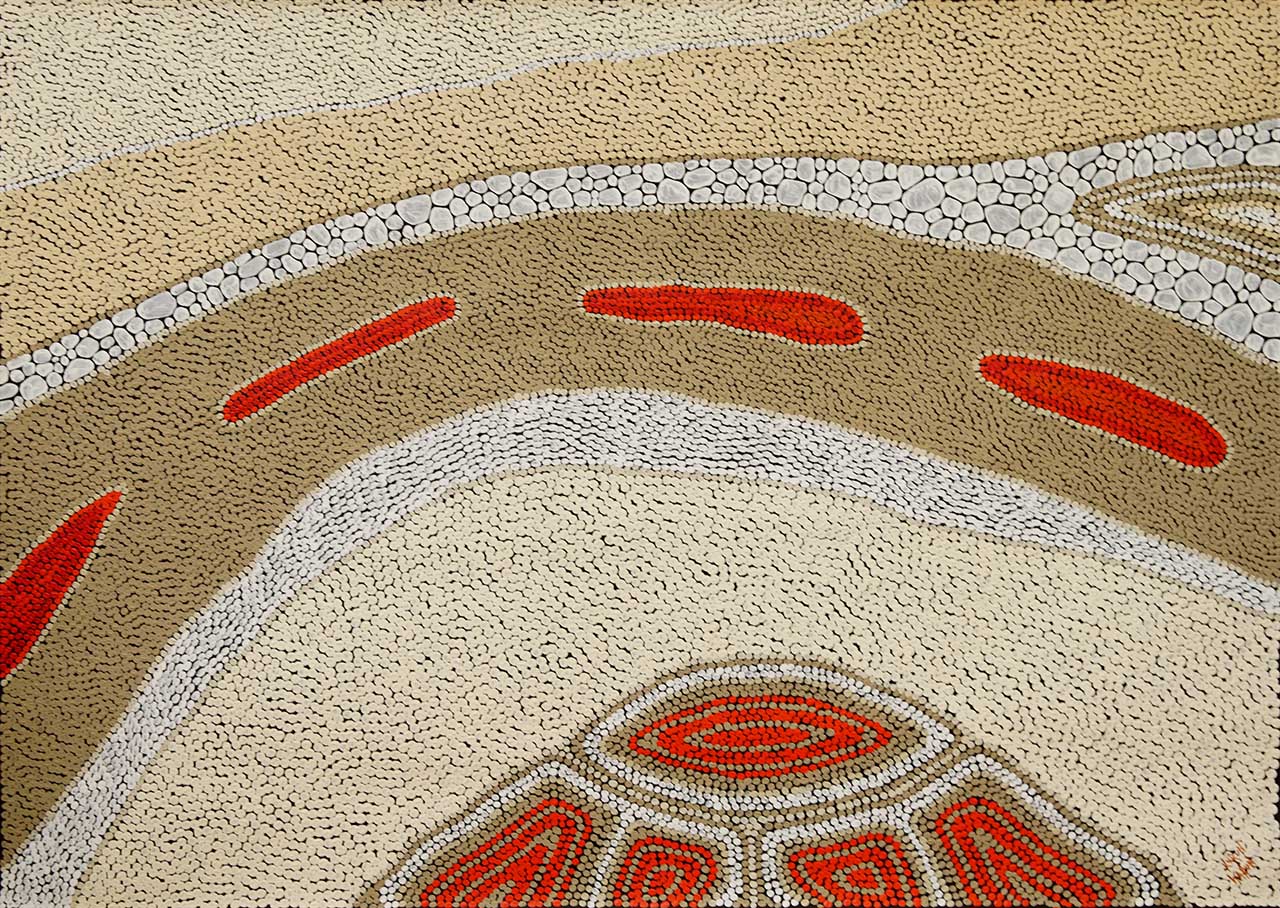
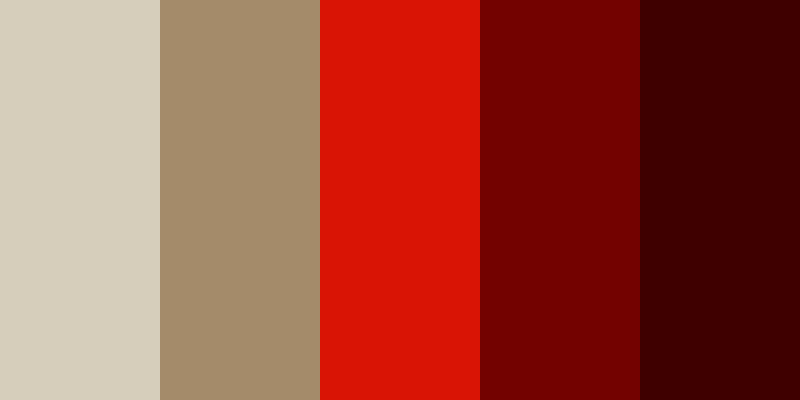
Kurun Warun | Dry River Bed
Kurun Warun is a contemporary Indigenous artist who paints landscape images that are recognisable from the dry Australian landscape. His series of Dry River Bed paintings use different size dots and marks to indicate the rocky and the grainy nature of the country. His palette moves across the dry and stony range of colours- off-whites, cream, tan colours. These set up the mood of the empty rocky river bed with the river course showing the movement of how water flows through this country when it floods. The colours all indicate that the river bed is dry for much of the year. The highlights of red against the white serve to remind us that the Australian landscape is dominated by a climate that sees drought and dry seasons as a significant part of the history of the country. Kurun Warun now lives on the coast, and his references are often about how Aboriginal people use watercourses and use the resources of the country as part of their knowledge and practice of land management.
(Jap 013540)
View Kurun Warun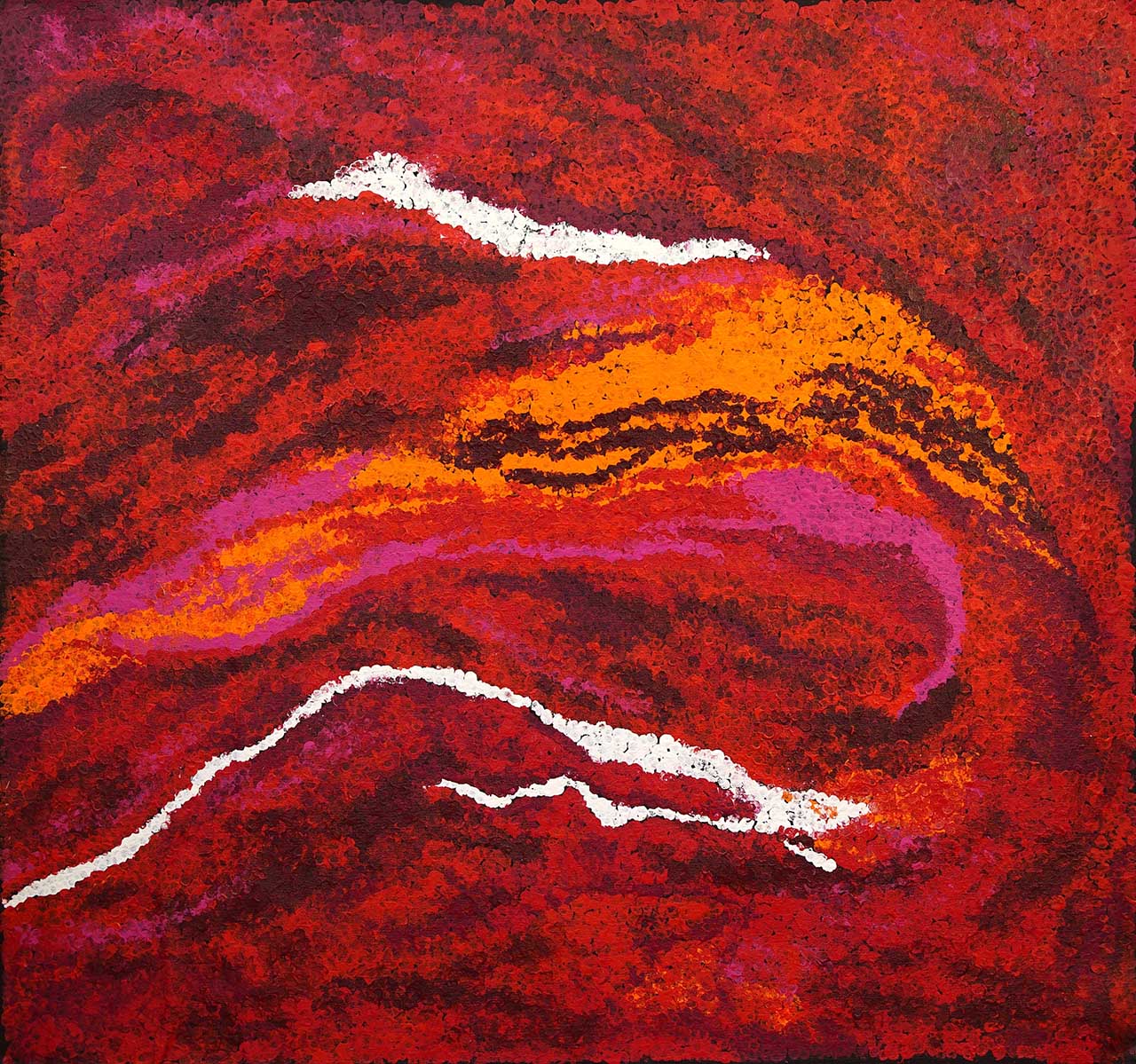

Tommy Watson | Wind Dreaming
The late Tommy Watson is well-known for his use of deeply symbolic colours. These are very dense colours, often employing strong reds, pinks and purples contrasted with orange and white, sometimes yellow. The effect is to create a lively painting that moves and shimmers on the surface and starts to look like a landscape seen from a great distance away with the sweeps of ridges and hills. But also in the work are stories that relate to Dreaming events from his Country, located where significant ceremonial sites are and people calling up the wind to clear the country and to cool the country. Tommy Watson has a distinctive way of using large blocks of colour, all quite organic in their shapes, that are created out of the large dabbing marks typical of the artist. But the painting itself swirls and moves within and across these blocks of colour, that’s the skill of this artist.
(Jap 013420)
View Tommy Watson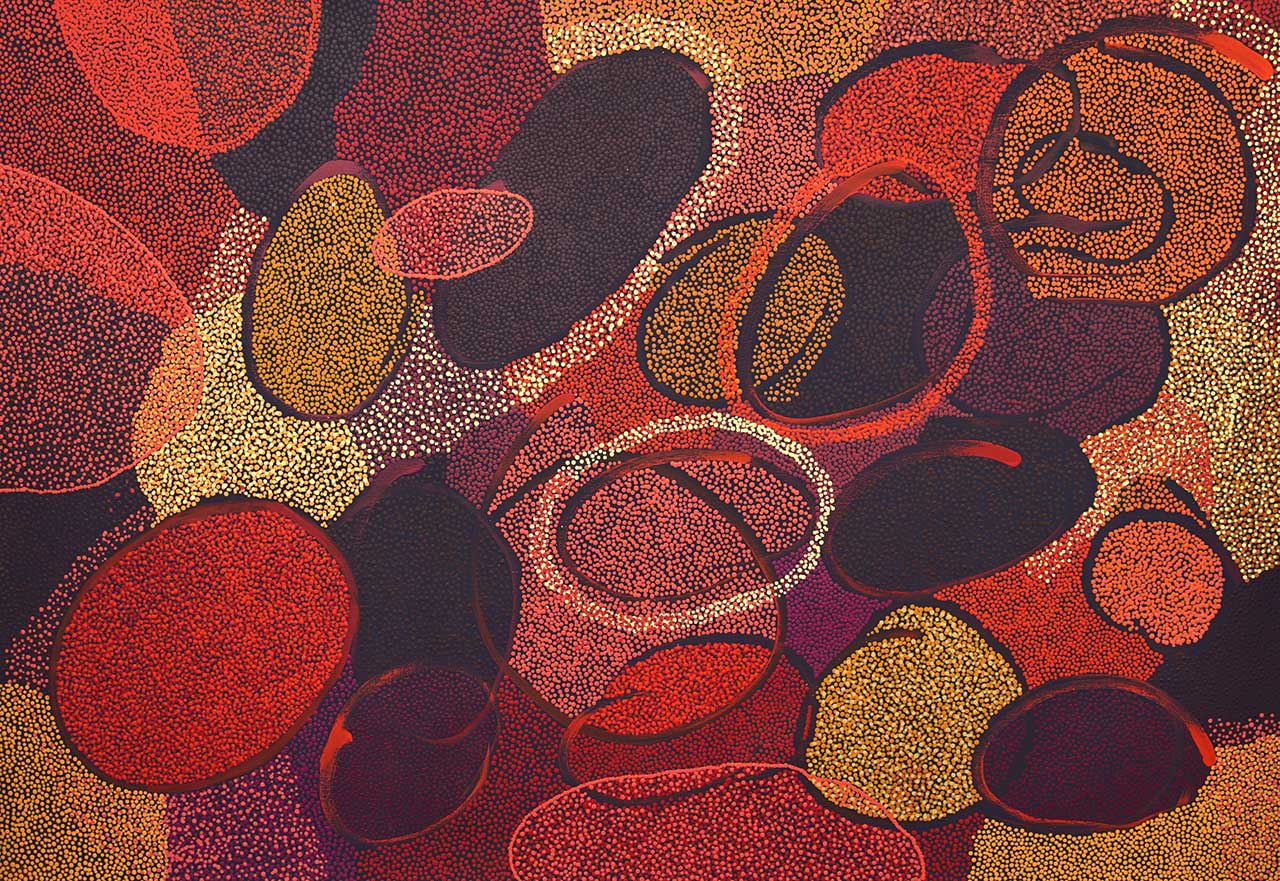
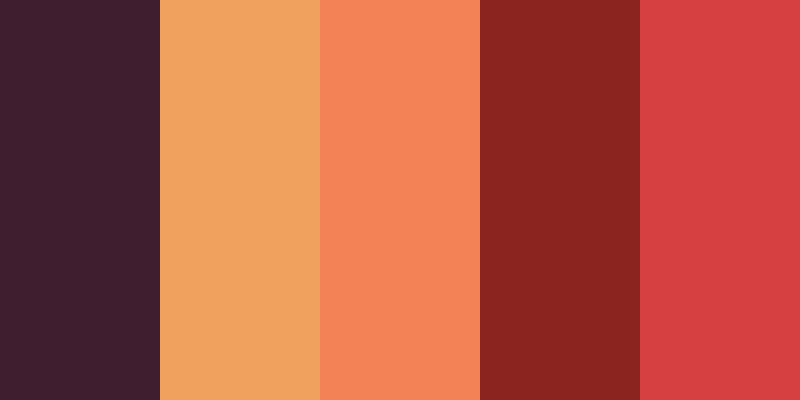
Felicity Nampijinpa Robertson | Water Dreaming
Felicity Nampijinpa Robertson is a Warlpiri artist from Yuendumu. Interestingly, she has painted a Water Dreaming site from this country but in this case she has used the hot and desert colours from the landscape. There are variations from rich red colours through dark browns and tobacco and yellow tones. She is painting a very significant story from Warlpiri country, but she is also reflecting the colours that we see most commonly in the landscape- a dry colour scheme. The Water Dreaming is also about senior custodians singing up the water, so there is a connection between dry country and the way people call up the rain.
(Jap 013367)
View Felicity Nampijinpa Robertson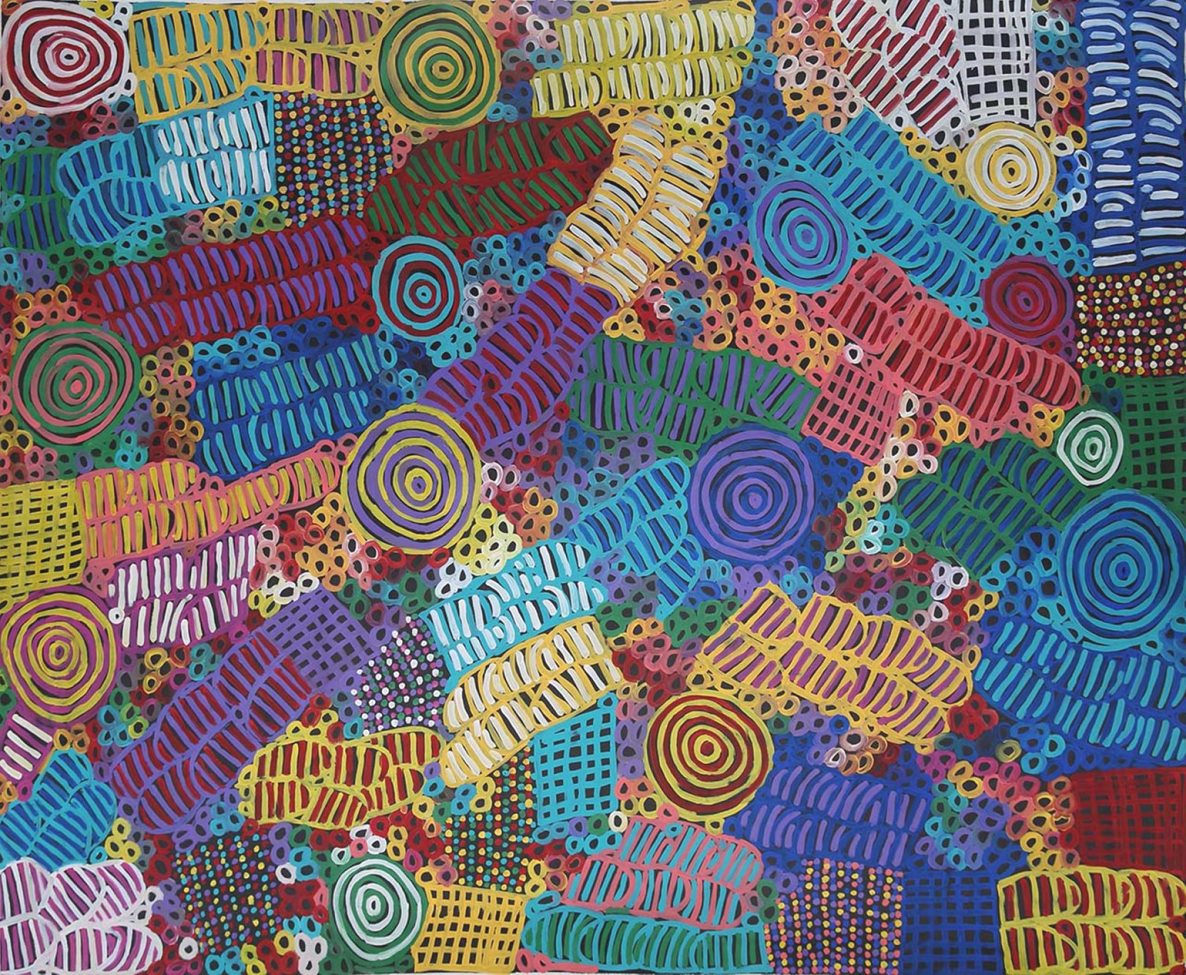

Betty Mbitjana | Awelye – Body Paint
Betty Mbitjana comes from a family of famous artists painting the Body Painting design from women’s ceremony. The design called Awelye depicts the patterns painted on the bodies of the participants, the women, when they come together for ceremonies. The painting directly refers to these body painting marks. What Betty has done in this painting is give it a life of its own through colour. So she has selected high impact colours placed with their complementary contrast colours all over the painting. On the dark sides, we have rich purples, deep blues, dark reds and very rich green colours. Then that’s offset against yellows and pinks, aqua green colours, and some softer tones of pink-mauve colours. So the artist has activated the design. Originally those ceremonial paintings were created using white ochre predominately and some yellow ochre. But the artist has taken the artistic liberty of using all the colours available to Indigenous artists in the modern era.
(Jap 010971)
View Betty Mbitjana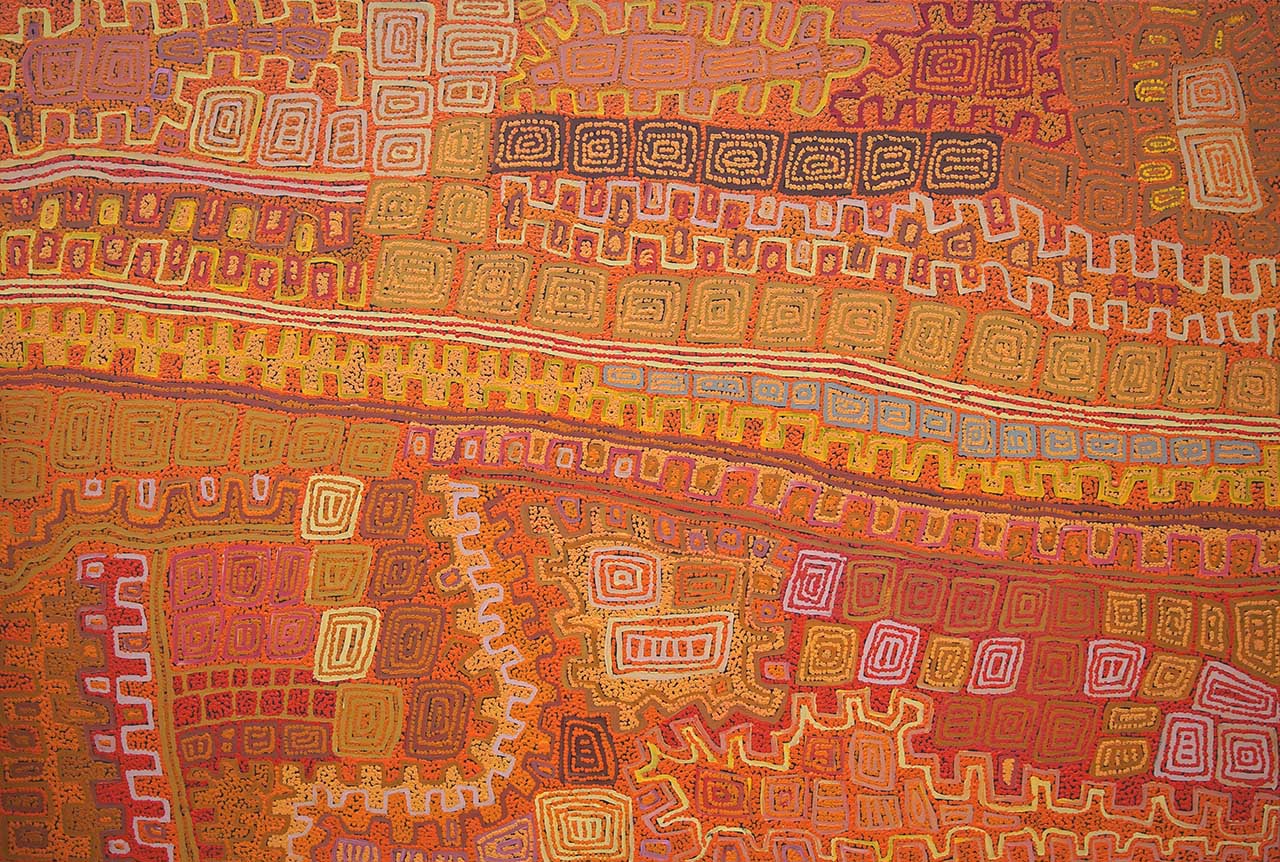

Patrick Tjungurrayi | Untitled – Tingari and Ancestral Country
The great Patrick Tjungurrayi painted the Tingari tracks or the Dreaming stories that crossed his country. In this painting he has used the colours of the desert. He sometimes uses softer colours, pale pinks and pinky-orange colours, but set against a very fiery group of deep reds and oranges. The design is made up of symbols related to men’s Dreaming stories, and the Tingari Ancestors who travelled across the country and created all the aspects of the landscape and locations of the ceremonial sites. These paintings from Patrick Tjungurrayi are loaded with significance in terms of the Creation stories of his country and the colours that he uses are warm and harmonious. They ring with the kind of intensity that comes from these deeply held Creation stories.
(Jap 010259)
View Patrick Tjungurrayi
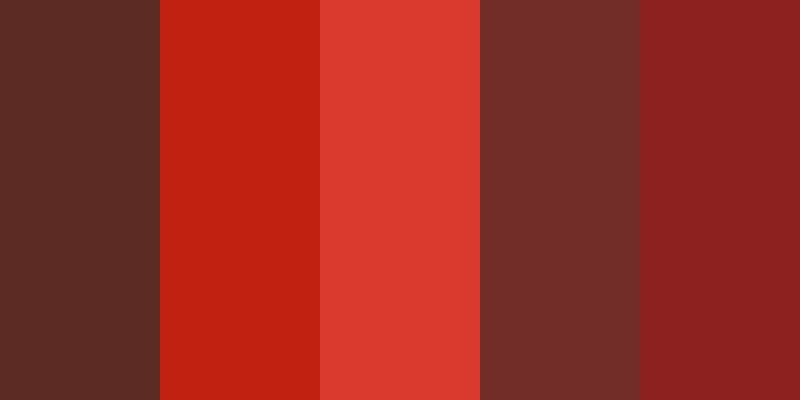
Kudditji Kngwarreye | Country – Fire Series
Kudditji Kngwarreye, the late and great artist, painted aspects of his country in a very abstract way. His selection of colour was about the mood of the country. In this painting from the Fire series, he has painted country using the complete range of red and deep red colours against a black background. Those tones of red reflect country when it is vulnerable to fire and burning off. This series of Fire paintings is offset against others related to the cool season and the rainy season, which feature large amounts of blue and greys. The artist is giving his recognition of the country in a way that tells you about the mood of the country and what is going on in terms of the environment and the climate.
(Jap 005455)
View Kudditji Kngwarreye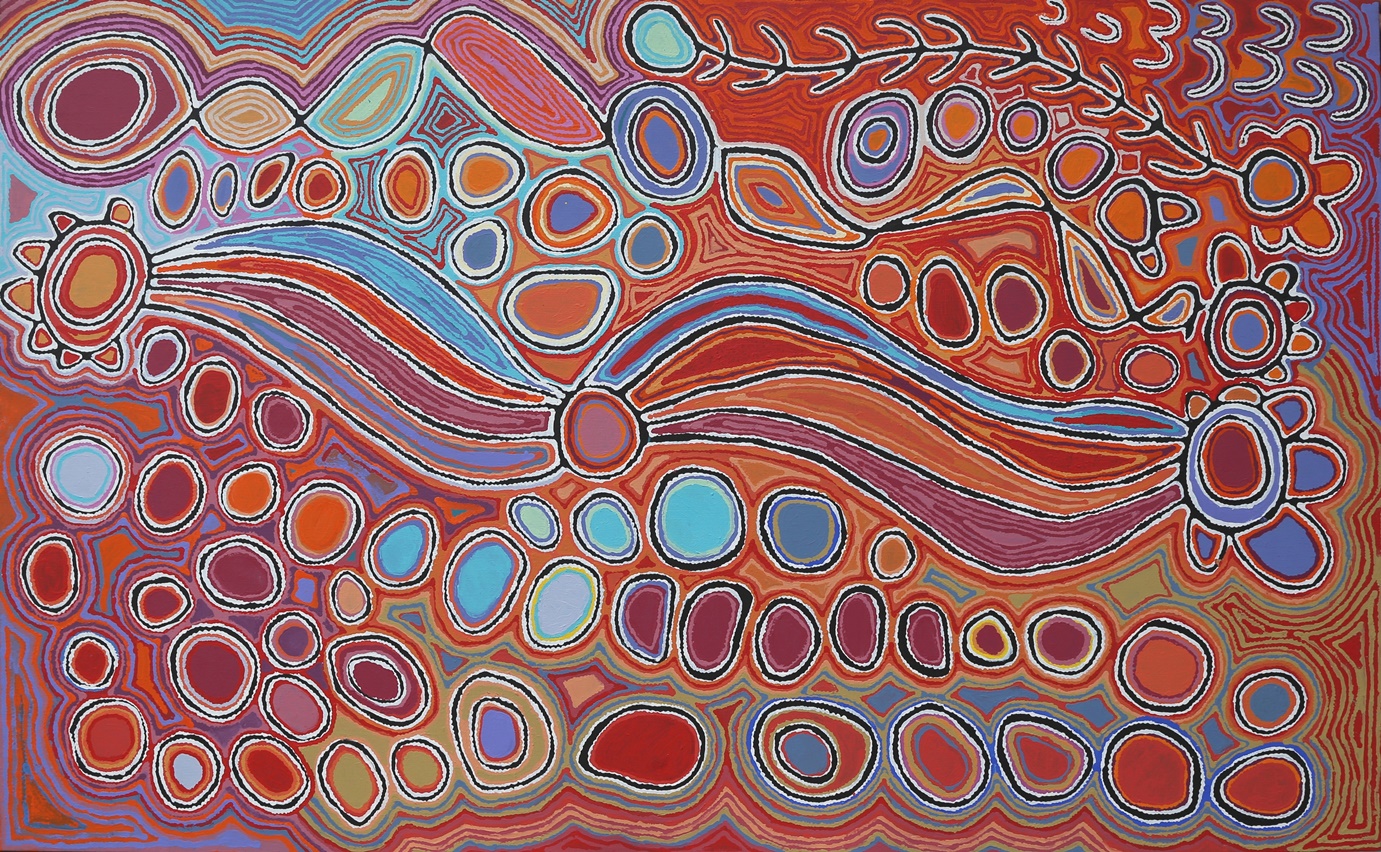

Judy Watson Napangardi | Mina Mina Jukurrpa
Judy Watson Napangardi paints images of Mina Mina Jukurrpa, the famous women’s ceremonial site. She paints aspects of the artefacts that the women weave as part of the ceremonial proceedings for the events at Mina Mina. In this painting she has used very strong colours that reflect the desert – the blues and mauves refer to the surrounding area that is a large salt lake. It has a significance in a ritualistic way and also it is a highly significant location. Judy has made this beautiful painting with intense colours that signifies a very important subject matter, aspects of a Dreaming story acted out by and shared by a large group of Warlpiri women right across the Tanami Desert, and even deep into the south of the country. The colours, the intensity and the brightness all come together in a very powerful design which is one of the aspects of her art for which Judy Watson Napangardi is so highly regarded.
(Jap 004877)
View Judy Watson Napangardi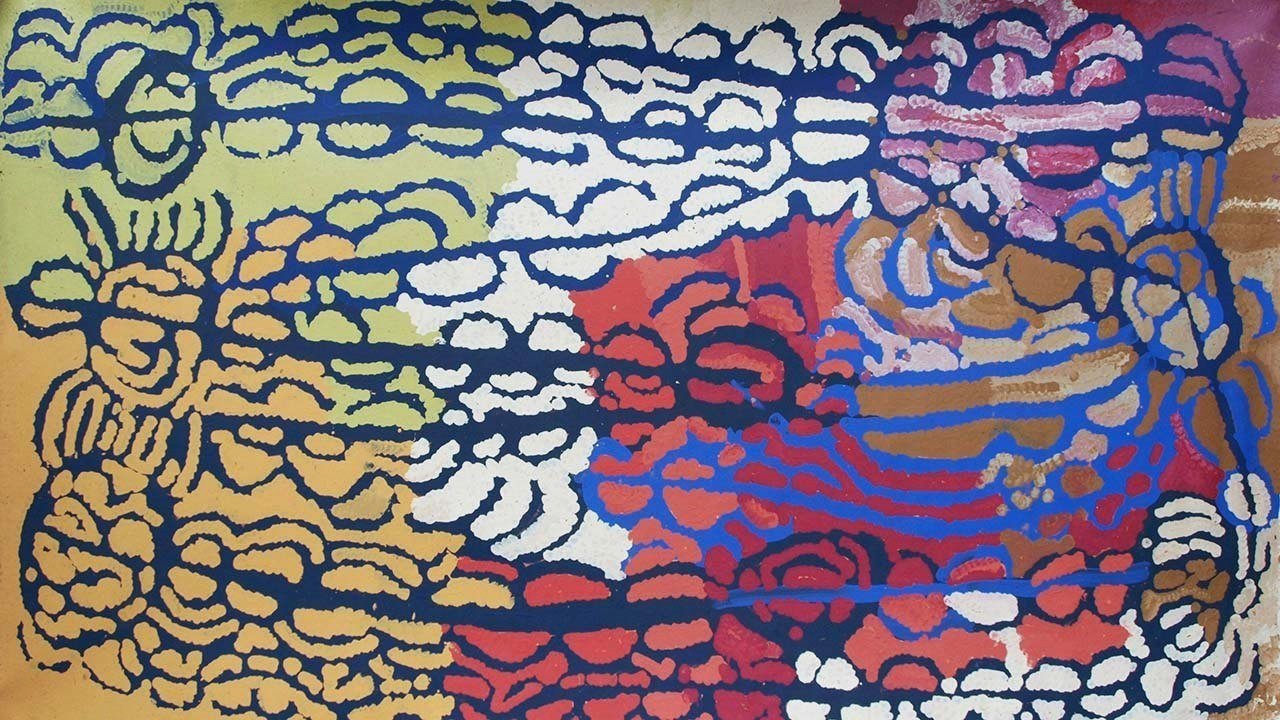

Lorna Napurrula Fencer | Wapirti – White Bush Potato
Lorna Napurrula Fencer is a great painter of the Yam Dreaming stories from her family’s Dreaming site. The story of the Yam or Bush Potato, is the story of how the Ancestors pulled the yam vine from out of the water reservoir that lay under the country. By starting that Creation site for the Yam the Ancestors set up a chain of events and stories that impact on Warlpiri people. Lorna Fencer is a great colourist, and a wonderful maker of designs based around the sprawling vine plants that are the bush yams found in the desert. In this painting she has offset two halves of the painting. On the left-hand side, she has golden yellow and lime green colours, and on the right-hand side she’s got deep reds, oranges and earth colours offset with the blue line structures that make the vine of the yam plant. You can see the use of contrasting colour to highlight a really important story for the artist. Ultimately in this story the yam leads to warfare between different groups of Ancestors, some of whom were custodians for the large yam and some were custodians for the smaller pencil yam. The ultimate story came down to the need to share resources to avoid major conflict within those small desert groups.
(Jap 001070)
View Lorna Napurrula Fencer